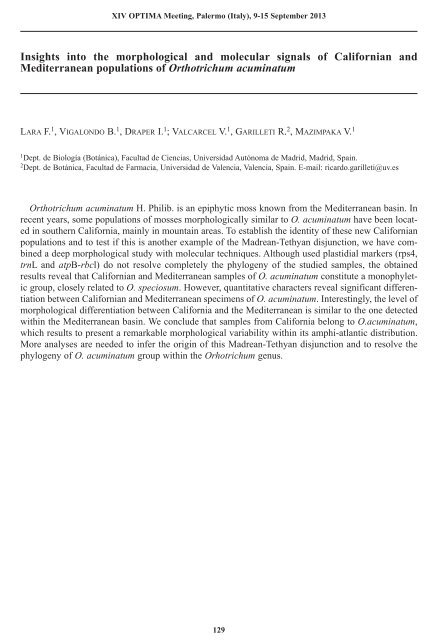Abstracts, XIV OPTIMA Meeting, Palermo (Italy) , 9-15
Abstracts, XIV OPTIMA Meeting, Palermo (Italy) , 9-15
Abstracts, XIV OPTIMA Meeting, Palermo (Italy) , 9-15
You also want an ePaper? Increase the reach of your titles
YUMPU automatically turns print PDFs into web optimized ePapers that Google loves.
<strong>XIV</strong> <strong>OPTIMA</strong> <strong>Meeting</strong>, <strong>Palermo</strong> (<strong>Italy</strong>), 9-<strong>15</strong> September 2013<br />
Insights into the morphological and molecular signals of Californian and<br />
Mediterranean populations of Orthotrichum acuminatum<br />
LARA F. 1 , VIGALONDO B. 1 , DRAPER I. 1 ; VALCARCEL V. 1 , GARILLETI R. 2 , MAZIMPAKA V. 1<br />
1 Dept. de Biología (Botánica), Facultad de Ciencias, Universidad Autónoma de Madrid, Madrid, Spain.<br />
2 Dept. de Botánica, Facultad de Farmacia, Universidad de Valencia, Valencia, Spain. E-mail: ricardo.garilleti@uv.es<br />
Orthotrichum acuminatum H. Philib. is an epiphytic moss known from the Mediterranean basin. In<br />
recent years, some populations of mosses morphologically similar to O. acuminatum have been located<br />
in southern California, mainly in mountain areas. To establish the identity of these new Californian<br />
populations and to test if this is another example of the Madrean-Tethyan disjunction, we have combined<br />
a deep morphological study with molecular techniques. Although used plastidial markers (rps4,<br />
trnL and atpB-rbcl) do not resolve completely the phylogeny of the studied samples, the obtained<br />
results reveal that Californian and Mediterranean samples of O. acuminatum constitute a monophyletic<br />
group, closely related to O. speciosum. However, quantitative characters reveal significant differentiation<br />
between Californian and Mediterranean specimens of O. acuminatum. Interestingly, the level of<br />
morphological differentiation between California and the Mediterranean is similar to the one detected<br />
within the Mediterranean basin. We conclude that samples from California belong to O.acuminatum,<br />
which results to present a remarkable morphological variability within its amphi-atlantic distribution.<br />
More analyses are needed to infer the origin of this Madrean-Tethyan disjunction and to resolve the<br />
phylogeny of O. acuminatum group within the Orhotrichum genus.<br />
129






